The Swedish Settlements of Phelps
and Kearney Counties
A metaphor for the events surrounding the coming of Swedish immigrants to the central Platte River valley of Nebraska might be taken from geology. Most geological records are found in layered sediments; bedrock is covered by strata of organic origin, seas appear with their characteristic deposits only to dry up and be again layered with fossil bearing strata.
But it is in the features revealed by the more dramatic, seismic events that geologists find their richest resources; the movement of the continental plates and upheaval of mountain ranges, breaking and opening to view the various levels which best tell the story of what has gone on through the ages.
The human story has a similar theme. Cultures and societies change and evolve slowly, but when a great migration such as that of the Swedes coming to America takes place as it did just a few generations ago something more dramatic appears. The displacement is like that of a mountain range being thrust upward. Changes that would normally be gradual are accelerated. Fissures are opened and unlikely combinations appear. The results are fascinating and revealing. A new and dramatic vista can be seen.
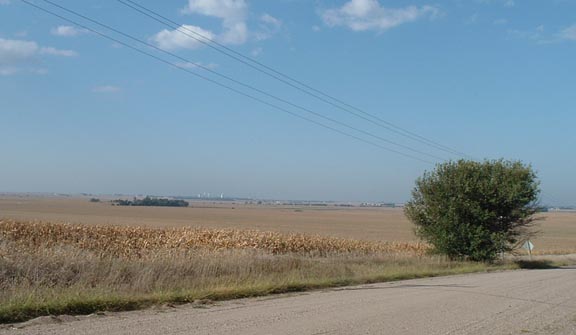
A Svea Settlement view from the "crest" of Moses Hill
Loomis is on the horizon
In the area of Phelps and Kearney Counties, from the Union Pacific Railroad of the Platte valley down to and beyond the Burlington Railroad at Axtell and Holdrege there is such a story to be told. In this quiet and serene countryside lies a record of formative times for a people and their religious history. Bring along your geologists' pick and fossil-hunting brush for a trip to "Svea", the largest Swedish settlement in Nebraska!
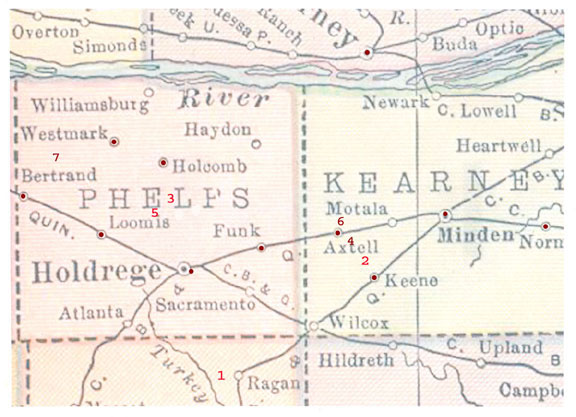
For orientation: 1. Scandinavia Post Office, (near Ragan); 2. Bethany "mother church";
3. Phelps Center; 4. Salem Methodist; 5. Moses Hill; 6. Bethphage Mission; 7. Adullam Lutheran
Red dots mark locations with Swedish churches
Native Americans supplied Nebraska with its name, which means "flat water", an allusion to the shallow, meandering Platte River which is the defining feature of the state and is seen at the top of the map above. Running from its western to eastern borders, it formed the natural pathway to America's frontier. The Oregon and Mormon Trails followed this path, as did the transcontinental railroad.
Pertinent to this story is not so much the rails and spikes, the steam engines and railcars themselves, but rather the real estate ventures of the railroad companies. This incentive of the U.S. government gave these companies the windfall of millions of acres of land to sell to propective farmers. And they were able to market and sell this land at ridiculously low prices by today's standards. Coupled with outright free land during the homesteading days, this windfall extended to everyone willing to give it a try. This was where the Swedes came in.
Should you visit "Svea", the wonderful museum on the north edge of Holdrege is paramount, but for an anchor point in the field it is easy to take the highway going south out of Kearney and continue on past its intersection with highway #6 toward the towering spire of Bethany church.

Bethany; sentinel and pioneer monument
Bethany has been a monument for over a century and was begun in the form of a "torv" or sod church. No photograph evokes such a sense of wonder at the religious determination of these people from Sweden as the one below. To stand on this site, at the west edge of the Bethany church burial grounds, is impressive. A story that "deserves to be told".

Bethany's founders, with trees they intend to plant
Our copy of Sandahl's history was once owned by Rev. Martin Lingwall, who was a resident of Midwest Covenant Home in Stromsburg while we served as administrator there. In the book was a typewritten page of Bethany history which he may have delivered at the time of its centennial. Here it is:
"Bethany Lutheran Church was founded one hundred years ago on September 4, 1876. Prior to that time, a man by the name of Beiyon settled in this area. Mr. Beiyon, a land agent, was a Swede himself and was responsible for luring Swedish immigrants from the East. It was at his home that a small group of pioneers met on September 4, 1876 and began organizing Bethany Lutheran Church.
The first church was a sod building located west of the present building. A monument, erected in 1954 marks the place where the sod church stood. It was built in the spring of 1878. It was 20 feet by 46 feet in size and was used as a church building up to the latter part of 1885.
The decision on the present church site was made in January, 1878, and plans for the new building were made in July, 1885. The building was started in August 1885 and completed toward the beginning of the new year at the cost of $6,000. On January 26, 1886, the first Annual Meeting was held in the new church.
The first parsonage was built in 1879 and the present one in 1898. In 1882 Bethany purchased its first organ. It was replaced with a $1200 pipe organ in 1896 and in 1915 a $3000 pipe organ was purchased. The organ served for sixty years with only minor repairs being made until 1975 when the congregation decided to have It completely rebuilt and revoiced.
The basement of the church was added and completed by January 195l. The sanctuary of the church was completely remodeled in 1951 to what it is today.
Bethany Lutheran Church reached its summit of membership in 1911 with 562 communicant members. Today, the total baptized membership Is 251, with 199 confirmed members." Rev. Martin Lingwall, 1976
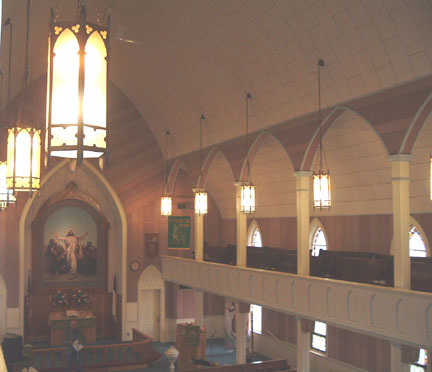
The distinctive interior of Bethany church
We are also indebted to David M. Gustafson, a Swedish descendant familiar with the Platte valley, for his work on the settlement of this area and its religious aspects. He particularly highlights the role played by the Swedish land agents who facilitated the marketing of the area to countrymen on both sides of the Atlantic. One of these was F.A. Beiyon, who in spite of his name was a Swede connected with the New Sweden area in southeast Iowa. The people pictured by the sod church above would have been very familiar with him. Two other such land agents were L. Hallgren and V. Rylander whose stories are told in detail by Gustafson. (click here)
This is my translation of a poem Beiyon wrote extolling the virtues of the region in his newspaper advertisements:
A picture trustworthy and sound
There sits a landowner with satisfied soul
With all of his friends gathered round
Certainly, he has the good sense to see
The benefits Providence brings
How prairie sunshine and prairie air
To body and soul give wings
Yes, see him sit and view with delight
His children at play, a wonderful sight
In the youthful land of Nebraska!

Land agent and sometimes poet
These land agents worked in cooperation with pioneer church leaders. Typically there would be special provisions for church sites to promote the development of congregations by the fledgling denominations in the new areas. This would be of benefit to all parties, and not a few early clergymen came to the frontier as owners of their own farms as well as pastors to their congregation. This too would be of benefit to all, since money was scarce. Just how scarce is illustrated by the following story:
"As far as the eye could reach in any direction, not a sign of human habitation was visible, except about three miles southeast, where Rylander and Hallgren were building an Emigrant House and digging a well for the accomodation of the colonists. Nothing but miles of level prairie burned black by the prairie fire. Hundreds of thousands of bleaching buffalo skeletons are scattered over the plains, showing what a terrible slaughter of these animals there has been... Many of the settlers make their living now by picking up buffalo bones, hauling them to Kearney and selling them at six dollars per ton." -Rolf Johnson, 1876
In scarcely two lifetimes this picture has faded almost completely into the realm of legend and lore, yet our great-grandparents saw it with their own eyes! From idyllic poem to harsh reality! There is a footnote about the buffalo bones story. One of the immigrant Swedes who moved up to Kearney began a business which continued till 1964; Bodinson's Store. He was the buyer of buffalo bones from his countrymen to the south, and reportedly ground them into meal for use as fertilizer which he was able to market widely.
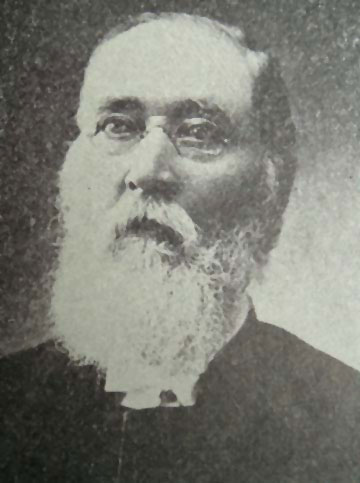

First Augustana Lutheran Pastor S.G. Larson and rails crossing the frozen Missouri
Swedish Lutheran Pastor S.G. Larson was sent to minister to the settlers of Nebraska shortly after its statehood, crossing the Missouri "on the ice". His field of ministry must have seemed vast, for he is recorded as visiting even distant "Svea" to conduct worship services for the newcomers. The story of Larson is found in the Saunders County section. These early services were otherwise led by laymen, licensed or otherwise, in immigrants' homes. One such home was that of Gustaf Hanson, who lived in the southern end of the settlement and was both storekeeper and postmaster at a place aptly called "Scandinavia" noted on our map. We will later learn that Danish Lutherans in the region also credit S.G. Larson with the founding of their work.
Such distant travel at such an early time was only possible through the wonders of railroads. It must have seemed a time-warp to those who also journeyed by oxcart and on foot. The Union Pacific would have made possible Larson's venture from Omaha or Saunders County to Kearney, where a wagon ride southward would have completed the trip. One early story involving a Swedish Methodist minister had him coming as far as Kearney but unable to find his way to "Svea." He reportedly conducted a meeting in that city and returned eastward.
But the Burlington was also laying rails westward in the southern part of the area, and the very choice of its route would have its impact on the churches. In the interest of finding the best location, central to the greatest number of potential members, the Lutheran leaders determined that Scandinavia was too far south. For building a church and making a tree claim, Hallgren promised them forty acres on the site now occupied by Bethany. According to the Augustana historian, only twenty were delivered, but that was enough. The saplings held by the members in the picture by the sod church above demonstrate the arborial part of the bargain!
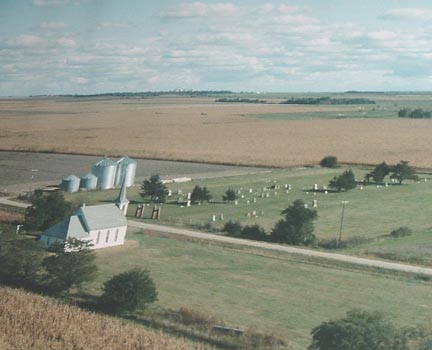
Immanuel, Scandinavia, before moving to the museum
Now we introduce a phenomenon that affects people and churches internally rather than externally. We might say we are back to sedimentation rather than seismology. To illustrate: some of the Scandinavia people did not follow their leaders to Bethany, but built their own church where they were. On the grounds of the Holdrege museum is wonderfully preserved their church building, Immanuel.
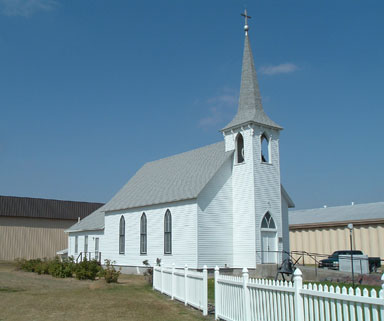
Immanuel, Scandinavia, at its present site at the Holdrege museum
From Augustana historian C.F. Sandahl we do not have a clear picture of a single pastor working with the land agents in the southern area. Reverend Setterdahl of Knoxville, Illinois, is mentioned and eastern Iowa is cited as the source of many of the people moving there. The new congregation is visited by mission pastors representing the Augustana Synod directly, the Kansas Conference, and clergy more Nebraska-oriented.
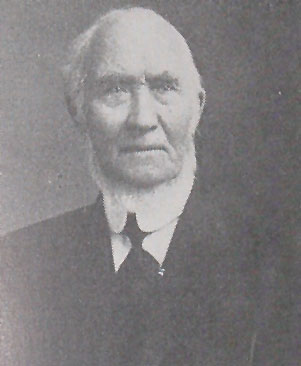
Pioneer lay pastor and blacksmith Olaf Hedlund
Setterdahl's friend, Olaf Hedlund, is instrumental in serving the group, but soon becomes involved with a new congregation to the west, which became Bethel of Holdrege. He may represent the kind of thinking that is evident in the reluctance of Scandinavia, Bethany and Bethel to keep church records in their early years. It is also said of Bethany that they held congregational meetings without the pastor's presence, and though they had access to two licensed pastors and an ordained one as well, still were "looking." This would not be mysterious to the student of Leander Hallgren's thinking, or to ideas in the wind among the Swedes at the time. There was a "free" inclination afoot, and one can only speculate what effect the Franson visit to this southern part of the region might have caused at the time.
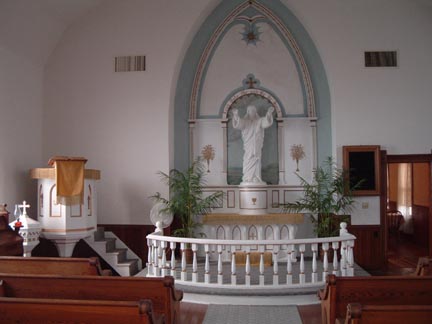
The altar of Immanuel with fellowship hall to the right
"Look unto me and be ye saved" reads the inscription
A case in point: the phrase "Look unto me and be ye saved" does not appear in my BibleWorks search software as being scriptural. It would, however, be a kind of slogan befitting Scott's Stockholm church or Moody's in Chicago. In these early Swedish Lutheran churches we have something quite different than what was to emerge later.
Back along the railroad line, Bethany's future was affected by its being bypassed by the Burlington. Augustana's historian remembers the motive of greed by a nearby landowner as forcing the railroad away from their settlement, and notes that he was not a Bethany member! This happenstance paved the way for new churches at Holdrege and Axtell, but these developments must wait till we look northwards to Vännersburg.
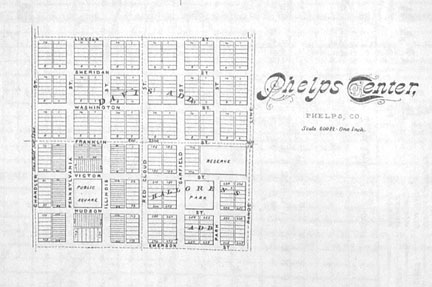
The grand plan for Vännersburg from the 1895 Atlas
Vännersburg ("Friends' Town",as its founders wanted to call it), or Phelps Center, Nebraska, as it was finally known, has a remarkable story. We have come to familiarity with it from two sources: Swedish Mission church history on one side, and family connections on the other. Nyvall Hall at North Park was named for Covenant educator and denominational leader David Nyvall. His father, C.J. Nyvall was a founder of the Mission Covenant of Sweden, and traveled to the Swedish centers of America in 1876. His first-hand observations from the frontier include the building seen below and are recorded in the book, "Travel Memories from America."
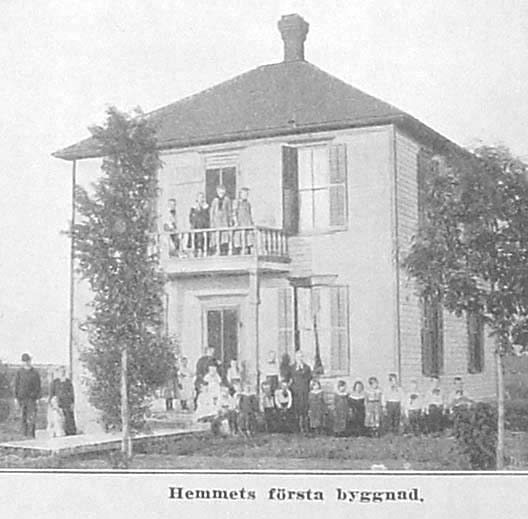
Former Immigrant House
In this building, which was built by railroad land agents Hallgren and Rylander, Swedish immigrant families were quartered while their dugouts and sod houses were constructed on new land. The children in the picture date from a later time, when the immigrant house had served its purpose and had taken on new life as an orphanage. Some had made the decision to move to the area in this very building, prospective visitors invited by the land agents as guests, and they would have heard the best in the salesmanship of the times. The harsh conditions of the frontier had Nyvall wondering about the judgement of those who would leave established homes for these stark conditions. He muses that the mission pastors of Sweden would complain less could they see the lot of their brethren here in Nebraska.
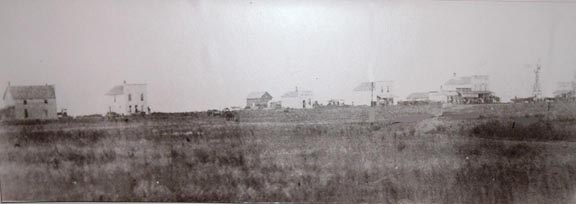
Early Phelps Center; Immigrant House joined by County Courthouse; others
And there were such pastors, for the practice of the railroad agents was to encourage such venturesome clergymen to act as leaders of immigrant groups with the incentive of free land for churches. Most of these men also became land owners in the new settlements, at what terms we can only speculate. The austerity of the early period is captured powerfully in the picture above.
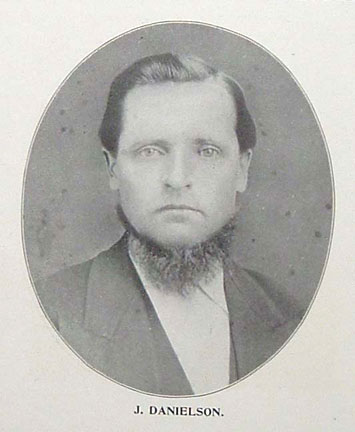
J. Danielson was the pastor who came to Vännersburg, preaching to a mixed group in this settlement house. Danielson had served as "vicar" or associate to E.A. Skogsbergh at the Minneapolis Swedish Tabernacle. Olaf Hedlund was another lay pastor working in the southern part of the region under the auspices of the Augustana synod. Immigrants to this southern section remember railroad agent Beiyon including a well-provisioned "happy hour" as part of his sales regime.
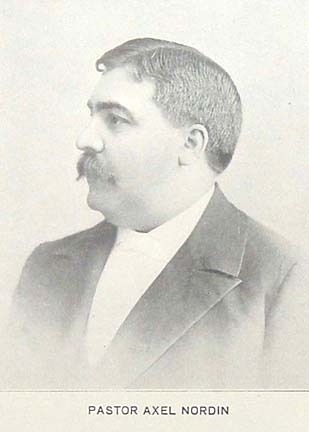
Rev. Axel Nordin was a learned and energetic mission preacher who had previously served as teacher in the Chicago mission school in John Martenson's Chicago-Bladet building. He figured in the Boone meeting of Free Mission leaders in 1885, and is known for building up the Phelps Center orphanage into the institution that survives today as Christian Homes of Holdrege. The immigrant house had surely yielded a bountiful return on its investment.

The Children's Home remained here till 1926
When controversy divided Danielson's "Moses Hill" church, the dissenting group returned once again to the immigrant house to hold their meetings. They proceeded to build their own church, which is now gone but succeeded by congregations at Holcomb and Holdrege. To the south, the sod churches of Augustana also endured growing pains, and not only endured but prevailed. The Bethphage home of Axtell was the institutional fruit of their labors.

The early plat for Vännersburg, renamed Phelps Center, contained many blocks and a town square. It was rival to Holdrege in size. Hallgren even published a newspaper called "Vårt Nya Hem", "Our New Home." Phelps Center reached its peak with the development of the Christian orphanage. The historical society is engaged in publishing a translation of a book about the orphanage. The picture above captures the farm, possibly the old immigrant house to the left, and the windmill at the well of which Rolf Johnson spoke. But the Burlington line which had missed Bethany to the south also bypassed Phelps Center to its north, and now all that remains is what you see below.
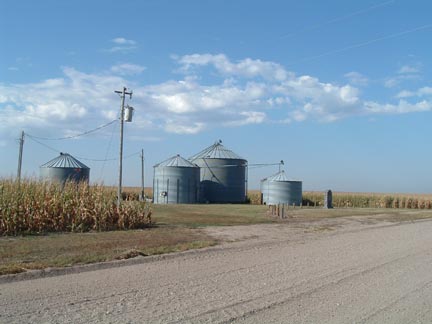
Only a marker for the orphanage (to the right) remains of Vännersburg/ Phelps Center
New land, new people, and new ideas came to Vännersburg. Hallgren was from the circle of Swedes in the Chicago north side community who were influenced by their nearby American neighbor D.L. Moody. His practical brand of Christianity was compassionate toward the "down and outers" but impatient with denominational structures. David Gustafson makes a strong case for the influence of this kind of thinking on the Swedes and points to the visit of Fredrik Franson to Phelps County as pivotal to developments there. Franson was a Swedish Baptist from Saunders County, we have written of him at length in that section. His message resonated with the friends of Vännersburg and his aggressive method of chartering new congregations, punctuated with a prophetic urgency, had dramatic effect. Briefly, he conducted preaching services which resulted in the division of the Moses Hill Mission church and the founding of new congregations at nearby Westmark and Keene.
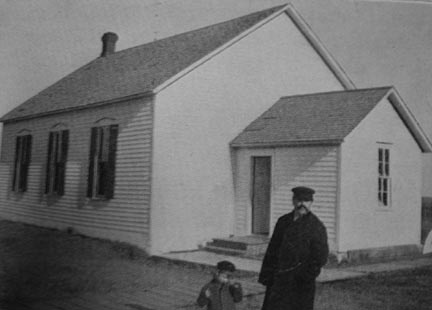
The first Moses Hill church, perhaps with Pastor Danielson
Back in Chicago, the Lutheran Swedes had an internal division of their own. In Sweden it could be said that if one were Swedish, one was automatically Lutheran. You might belong to a "mission society" or other group, but always under the umbrella of the state church. There was tension growing between these mission groups and the official hierarchy, and that translated to the American scene dramatically. Pastor J. Danielson was one of those "mission friends" who were banding together independently as a Lutheran mission synod, by that very name, feeling that the existing Swedish Augustana Lutheran Synod formed a decade before was flawed. Danielson served the role of settlement pastor for Hallgren in the same way the Bethany church had been formed. Land was given for the site with the overlook shown at the top of this piece, and a frame church built (though a sod structure had been considered).
Perhaps neither Hallgren nor Danielson were quite prepared for the fluidity of changes in the mission friend community. As noted, following the Franson visit the Moses Hill congregation divided; those leaving were refunded their contributions to the building fund and they met initially back in the old Immigrant House. Later they built their own church there at what was now called Phelps Center. The Moses Hill pastor was understandably distressed with this turn of events, but the Mission Synod and its successor, the Mission Covenant, would never thrive in Phelps County and few Lutherans penetrated north of the Burlington.
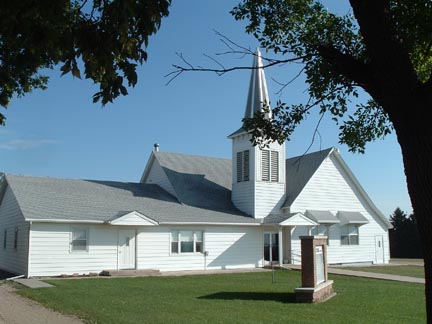
Moses Hill continues today, a survivor
The Fransonite expatriates from Moses Hill built the church below, which survived till 1916. The story of the rural Swedish Immanuel Church at Holcomb, a few miles north, was said to have absorbed some of these members as well as those of a church called "Rose Hill". Others went to Trinity at Holdrege to the south. Never ones to waste a building, the Swedes may have converted the building into the farmhouse which stands in the general area described.
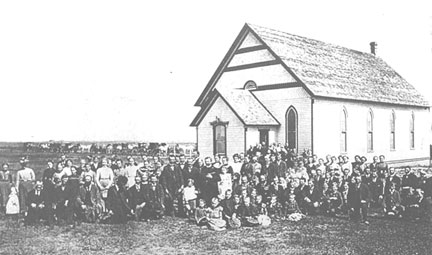 _
_
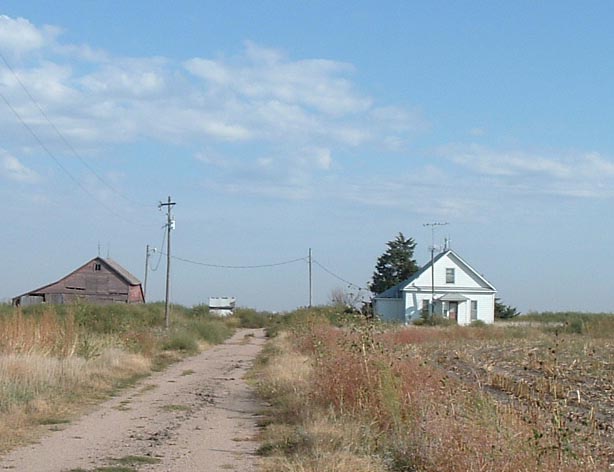
Phelps Center Church. Could it survive as this farmhouse?
For the perspective of the Mission Synod (later Covenant) pastor at Moses Hill church, Covenant historian Karl Olsson found this:
"In 1880 an itinerant named Franson came to visit the place and stayed for a short time. On the suggestion of some of the members of the church he used both his preaching and his associating with the people as a means of division so that the majority of the members through his leadership formed a Free church. The reason for this confusion was allegedly to achieve a better congregation. Because of the constitution agreed upon when the church was organized, the remaining members kept the church building."
Without dwelling on the negative, it must be said that regrettable walls were raised during this period which perhaps needlessly separated believers to this day. This was the part of Phelps County church history we think of as "seismic". But within the walls themselves there were interesting developments.